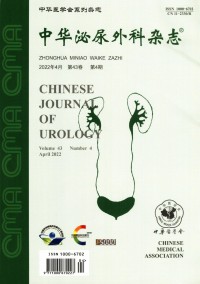Modified extraperitoneal laparoscopic VIP (Vattikuti institute prostatectomy) for prostate cancer: initial experience
Q4 Medicine
引用次数: 0
Abstract
Objective To investigate the operating key steps and the initial experience of IUPU (Institute of Urology, Peking University) modified extraperitoneal laparoscopic VIP (Vattikuti institute prostatectomy) technique and the initial follow-up outcomes. Methods 46 patients of prostate cancer underwent the modified extraperitoneal laparoscopic VIP and were reviewed from November 2017 to September 2018. Patients aged 54 to 77 years, with mean age of 65.5 years old. Their preoperative PSA was 0.15 to 69.76 ng/ml with an average of 13.4 ng/ml. All patients were diagnosed by prostate biopsy and Gleason score was 6 to 10 with an average of 7.5. MRI was used to assess their clinical stage before operation. All the modified laparoscopic VIP were done through the extraperitoneal approach by a single surgeon and the follow-up by telephone for the PSA level and continence recovery (urine pad test). The major differences between modified laparoscopic VIP and the routine steps of radical prostatectomy are as follows: use of extraperitoneal approach and traditional laparoscopic operation; after the setup of the extraperitoneal cavity, the bladder neck is separated, isolated and cut down first; the management of DVC: Cut down the super-facial and deep layers of DVC just along the capsule of the prostate apex and it’s unnecessary to suture it. Perioperative data of these patients were collected retrospectively, including operation time, intraoperative blood loss, length of hospital stay, postoperative pathology, and continence outcome after surgery. Result All 46 patients underwent the IUPU modified extraperitoneal laparoscopic VIP successfully without converting to open surgery. The operation time was 69-143 min with an average of 95.7 min and the estimated blood loss was 20-200 ml with an average of 81.5 ml. It was 3-17 days for the average time to remove the retropubic drainage tube postoperatively, with an average of 4.3 days. The postoperative hospital stay was 3-17 days with an average of 5.3 days. The Foley catheter was removed 14 days postoperatively. Five patients suffered from urine leakage and were managed successfully with conservative treatment. For the postoperative pathological stage, 1 patient was pT2a, 12 patients were pT2c, 12 patients were pT3a and 21 patients were pT3b. The postoperative Gleason score was 6-9 with an average of 7.7. The postoperative follow-up time was 1-11 months with an average of 6.3 months. The PSA was 0.001-0.966 ng/ml with an average of 0.181 ng/ml 1 month postoperatively and the continence rate was 54%(25/46) and 89%(34/38) 1 month and 3 months after operation respectively. Conclusions The IUPU modified extraperitoneal laparoscopic VIP might be a safe and feasible for the radical prostatectomy. It’s simplified for the operative steps, unnecessary to isolate and suture DVC and doesn’t increase the blood loss. It’s almost left intact for the surrounding tissues of the prostate apex and satisfactory for the early urinary continence. The oncological outcomes are needed to followup further. Key words: Prostate neoplasms; Radical prostatectomy; Laparoscopic; Vattikuti institute prostatectomy (VIP); Urinary continence改良腹膜外腹腔镜VIP(Vattikuti研究所前列腺切除术)治疗前列腺癌症:初步经验
目的探讨IUPU(北京大学泌尿外科研究所)改良腹膜外腹腔镜VIP(瓦蒂库蒂研究所前列腺切除术)技术的操作要点、初步经验及初步随访结果。方法2017年11月至2018年9月,对46例癌症前列腺癌患者进行改良腹膜外腹腔镜VIP检查。患者年龄54~77岁,平均年龄65.5岁。术前PSA为0.15~69.76 ng/ml,平均13.4 ng/ml。所有患者均经前列腺活检诊断,Gleason评分为6至10分,平均7.5分。术前应用MRI评估其临床分期。所有改良腹腔镜VIP均由一名外科医生通过腹膜外入路进行,并通过电话随访PSA水平和失禁恢复(尿垫试验)。改良腹腔镜VIP与常规根治性前列腺切除术的主要区别在于:腹膜外入路与传统腹腔镜手术;腹膜外腔建立后,首先对膀胱颈进行分离、隔离和切割;DVC的处理:沿着前列腺尖包膜切开DVC的表层和深层,无需缝合。回顾性收集这些患者的围手术期数据,包括手术时间、术中失血量、住院时间、术后病理和术后失禁结果。结果46例患者均顺利完成了IUPU改良腹膜外腹腔镜VIP手术,未转为开放手术。手术时间为69-143min,平均95.7min,估计失血量为20-200ml,平均81.5ml。术后取出耻骨后引流管的平均时间为3-17天,平均4.3天。术后住院3~17天,平均5.3天。术后14天取出Foley导管。5名患者出现尿漏,并通过保守治疗成功治疗。对于术后病理分期,1例患者为pT2a,12例患者为p T2c,12例为pT3a,21例为p T3b。术后Gleason评分为6-9分,平均7.7分。术后随访时间1~11个月,平均6.3个月。PSA为0.001-0.966 ng/ml,术后1个月平均为0.181 ng/ml,1个月和3个月的控尿率分别为54%(25/46)和89%(34/38)。结论IUPU改良腹膜外腹腔镜VIP术是一种安全可行的前列腺根治术。它简化了手术步骤,不需要隔离和缝合DVC,也不会增加失血。前列腺尖周围组织几乎完好无损,对早期尿失禁也很满意。肿瘤学结果需要进一步随访。关键词:前列腺肿瘤;根治性前列腺切除术;腹腔镜;瓦蒂库蒂研究所前列腺切除术;尿失禁
本文章由计算机程序翻译,如有差异,请以英文原文为准。
求助全文
约1分钟内获得全文
求助全文
来源期刊

中华泌尿外科杂志
Medicine-Nephrology
CiteScore
0.10
自引率
0.00%
发文量
14180
期刊介绍:
Chinese Journal of Urology (monthly) was founded in 1980. It is a publicly issued academic journal supervised by the China Association for Science and Technology and sponsored by the Chinese Medical Association. It mainly publishes original research papers, reviews and comments in this field. This journal mainly reports on the latest scientific research results and clinical diagnosis and treatment experience in the professional field of urology at home and abroad, as well as basic theoretical research results closely related to clinical practice.
The journal has columns such as treatises, abstracts of treatises, experimental studies, case reports, experience exchanges, reviews, reviews, lectures, etc.
Chinese Journal of Urology has been included in well-known databases such as Peking University Journal (Chinese Journal of Humanities and Social Sciences), CSCD Chinese Science Citation Database Source Journal (including extended version), and also included in American Chemical Abstracts (CA). The journal has been rated as a quality journal by the Association for Science and Technology and as an excellent journal by the Chinese Medical Association.
 求助内容:
求助内容: 应助结果提醒方式:
应助结果提醒方式:


